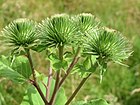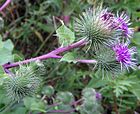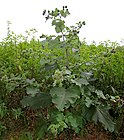Note: This is a project under development. The articles on this wiki are just being initiated and broadly incomplete. You can Help creating new pages.
Difference between revisions of "Beta vulgaris - Raktagrnjana"
(→References) |
|||
| Line 92: | Line 92: | ||
<references> | <references> | ||
| − | <ref name="chemical composition">[https://www.ijser.org/researchpaper/Chemical-composition-functional-properties-and-processing-of Beetroot.pdf"chemical composition"]</ref> | + | <ref name="chemical composition">[https://www.ijser.org/researchpaper/Chemical-composition-functional-properties-and-processing-of Beetroot.pdf "chemical composition"]</ref> |
<ref name="Leaf">[http://powo.science.kew.org/taxon/urn:lsid:ipni.org:names:164505-1 "plant description"]</ref> | <ref name="Leaf">[http://powo.science.kew.org/taxon/urn:lsid:ipni.org:names:164505-1 "plant description"]</ref> | ||
Revision as of 12:24, 14 May 2018
The beetroot is the taproot portion of the beet plant,[1] usually known in North America as the beet, also table beet, garden beet, red beet, or golden beet. It is one of several of the cultivated varieties of Beta vulgaris grown for their edible taproots and their leaves. Other than as a food, beets have use as a food colouring and as a medicinal plant. Many beet products are made from other Beta vulgaris varieties, particularly sugar beet.
Contents
- 1 Uses
- 2 Parts Used
- 3 Chemical Composition
- 4 Common names
- 5 Properties
- 6 Habit
- 7 Identification
- 8 List of Ayurvedic medicine in which the herb is used
- 9 Where to get the saplings
- 10 Mode of Propagation
- 11 How to plant/cultivate
- 12 Commonly seen growing in areas
- 13 Photo Gallery
- 14 References
- 15 External Links
Uses
tumours, anaemia, yellow jaundice, ringing ears, alleviate toothache, cancer, dandruff, leukaemia, bladder infections.
Parts Used
Chemical Composition
Beetroots (Beta vulgaris) are rich in valuable, active compounds such as carotenoids (Dias et al., 2009), glycine betaine, (de Zwart et al., 2003), saponins (Atamanova et al., 2005), betacyanines (Patkaiet al., 1997), folates (Jastrebova et al., 2003), betanin, polyphenols and flavonoids [1]
Common names
| Language | Common name |
|---|---|
| Kannada | |
| Hindi | |
| Malayalam | |
| Tamil | |
| Telugu | |
| Marathi | NA |
| Gujarathi | NA |
| Punjabi | NA |
| Kashmiri | NA |
| Sanskrit | |
| English | Greater Burdock, Bardana |
Properties
Reference: Dravya - Substance, Rasa - Taste, Guna - Qualities, Veerya - Potency, Vipaka - Post-digesion effect, Karma - Pharmacological activity, Prabhava - Therepeutics.
Dravya
Rasa
Guna
Veerya
Vipaka
Karma
Prabhava
Habit
Identification
Leaf
| Kind | Shape | Feature |
|---|---|---|
| Simple | Basal leaves forming a rosette |
Flower
| Type | Size | Color and composition | Stamen | More information |
|---|---|---|---|---|
| Unisexual | 3.5–4 cm | green | 5-20 | Small, green, borne in clusters subtended by bracts, forming dense, usually branched inflorescences |
Fruit
| Type | Size | Mass | Appearance | Seeds | More information |
|---|---|---|---|---|---|
| Flattish | 7–10 mm | ‘Seeds’ are actually fruits that are attached to each other and enveloped in a woody covering | many | {{{5}}} | {{{6}}} |
Other features
List of Ayurvedic medicine in which the herb is used
- Vishatinduka Taila as root juice extract
Where to get the saplings
Mode of Propagation
How to plant/cultivate
Beta vulgaris is originally a native of the warm temperate zone, though it has spread further north to the cold temperate zone[3]
Commonly seen growing in areas
Waste ground, preferring calcareous soils, meadows and woods.
Photo Gallery
References
External Links
- Ayurvedic Herbs known to be helpful to treat tumours
- Ayurvedic Herbs known to be helpful to treat anaemia
- Ayurvedic Herbs known to be helpful to treat yellow jaundice
- Ayurvedic Herbs known to be helpful to treat ringing ears
- Ayurvedic Herbs known to be helpful to treat alleviate toothache
- Ayurvedic Herbs known to be helpful to treat cancer
- Ayurvedic Herbs known to be helpful to treat dandruff
- Ayurvedic Herbs known to be helpful to treat leukaemia
- Ayurvedic Herbs known to be helpful to treat bladder infections
- Herbs with Leaves used in medicine
- Herbs with stem used in medicine
- Herbs with Roots used in medicine
- Herbs with common name in English
- Habit - Biennial plant
- Index of Plants which can be propagated by Seeds
- Index of Plants which can be propagated by Cuttings
- Herbs that are commonly seen in the region of Waste ground
- Herbs that are commonly seen in the region of preferring calcareous soils
- Herbs that are commonly seen in the region of meadows and woods
- Herbs









